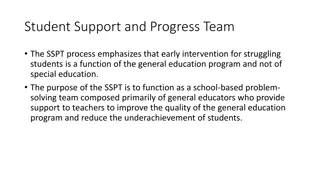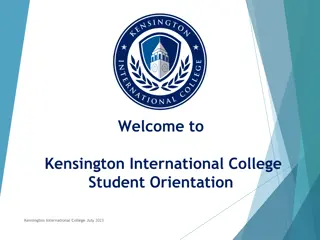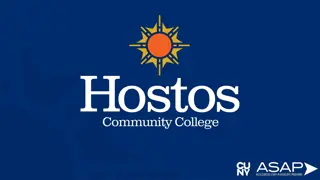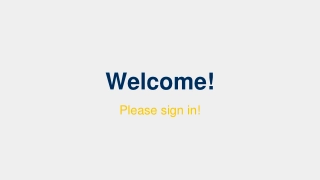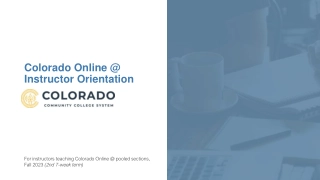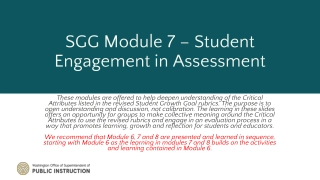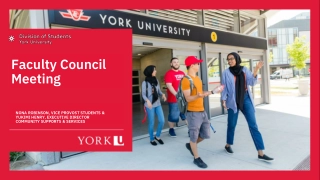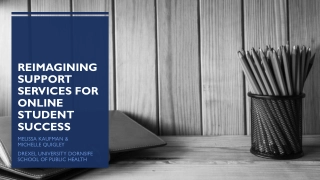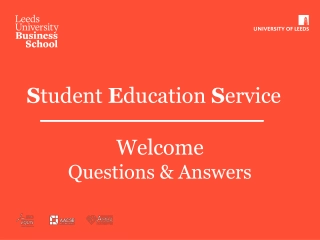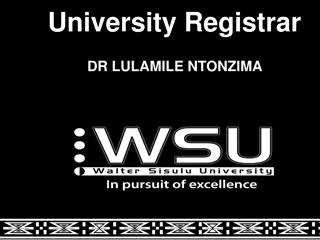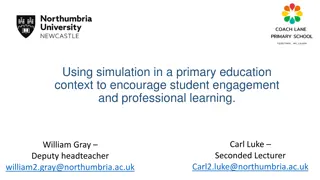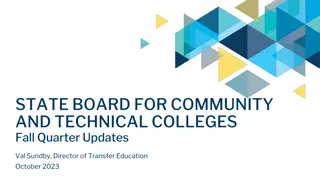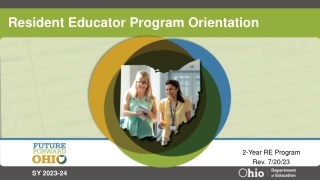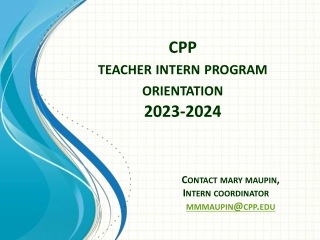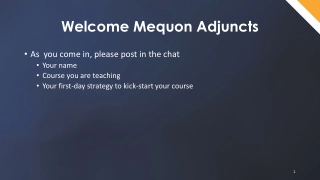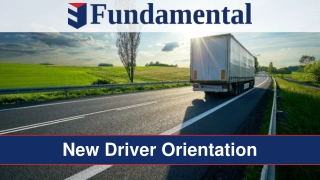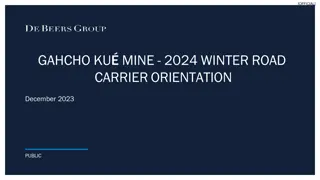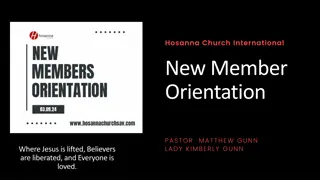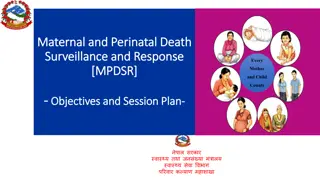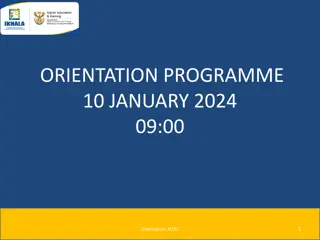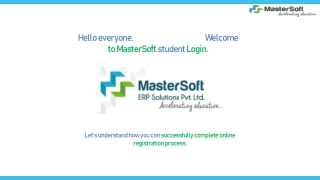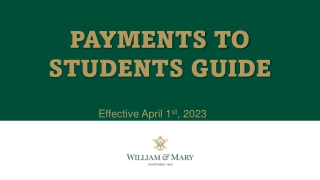Student Orientation
Welcome to the Student Orientation 2024 at Mount Nittany Health. This orientation covers student expectations, policies, patient safety, confidentiality, and computer access. Learn how to log in, change passwords, and access important resources. Ensure you track your hours accurately through Volgistics using provided methods. Join us in shaping the healthcare providers of the future!
Download Presentation
Please find below an Image/Link to download the presentation.
The content on the website is provided AS IS for your information and personal use only. It may not be sold, licensed, or shared on other websites without obtaining consent from the author. Download presentation by click this link. If you encounter any issues during the download, it is possible that the publisher has removed the file from their server.
Presentation Transcript
Student Orientation 2024
Welcome! Mount Nittany Health is proud of the care and service provided to our patients and our community, and we re pleased to share our expertise and resources by educating the healthcare providers of the future.
Welcome! This orientation will provide you with information regarding: Student expectations Policies and procedures Patient safety Confidentiality
Computer Access Throughout this orientation presentation, you will be asked to read linked documents and policies. In order to view these documents and policies, you will need to access Connect, the Mount Nittany Health intranet portal.
Computer Access Let s start by logging into the network and changing your password. Please go to https://apps.mountnittany.org. Enter the username and temporary password that was provided to you by your instructor. Change your password. Make sure it contains: At least 8 characters A capital letter Either a number or special character No part of your name
Computer Access Once you have changed your password, please go to https://portal.mountnittany.org. Enter your username and new password. This will allow you to access the Connect page. Leave Connect open while you view the rest of this orientation presentation. As you click on each linked document and policy throughout this presentation, the document or policy will open through Connect.
Logging your Hours You must sign in and out of Volgistics every time you are here as a student. You will receive your Volgistics PIN from the student coordinator or your instructor.
Logging your Hours There are 3 ways to access Volgistics: 1. Use the iPad that is located on the basement floor ofthe medical center, near the studentlockers. 2. Log onto a Mount Nittany Health computer andaccess Connect. 3. Use a link on your phone that may be provided by your instructor.
Logging your Hours Tracking your hours allows us to: 1. Know who is on-site at a particular time in case of emergency. 2. Identify who may have interacted with certain patients at a particular time. 3. Quantify and report student experiences as a benefit to the community. 4. Provide a record of your completed student hours to you or your instructor as requested.
Parking When arriving at Mount Nittany Medical Center, please park in the back of Lot C or in the back of any employee lot. Do not park in any employee or visitor lot. We will issue you a student ID badge and parking pass. Please hang your parking pass from your rearview mirror. Lot C
Student ID Badge You must wear your Mount Nittany Health student ID badge at all times when you are here. Please wear your ID badge on your chest so others can see it clearly.
Student ID Badge Never leave your badge unsecured, as it is programmed with access to certain doors at the hospital and could pose a security risk if lost. If you lose your badge, immediately tell your instructor and notify us at 814.234.6187. We will deactivate that badge and issue you a new one. Replacement badges cost $10 each. Your badge must be returned to us at the end of your student experience. Please review our ID badge policy.
Personal Belongings Please do not bring your belongings onto the clinical units. You may secure your belongings in a locker on the basement floor of Mount Nittany Medical Center. Just remember to: Bring your own padlock Empty your belongings at the end of each day
Professionalism Take pride in your journey to become a healthcare professional. Keep conversations appropriate, quiet, and related to patient care. Do not bring your phone with you to clinicals, unless you need it for emergency purposes and have cleared it with your instructor. Do not congregate in the staff work stations or patient care areas.
Professionalism Remember to introduce yourself to each patient for whom you provide care: Who you are What type of student you are What school you are from Your role in the patient s care Hi! My name is Lindsay, and I am a nursing student from CPI. I m working with your RN, Lucy, today.
Professionalism During any clinical free time (if you are caught up on your patient care and documentation), please consider emptying patient trash cans and dirty linen hampers, offering assistance to staff, or tidying work stations or patient care areas. Teamwork is an essential part of the nursing profession, and good student habits will carry over into your professional career.
Professionalism The quality of your experience depends on you! To get the most out of your experience, engage with various members of the healthcare team and seek out opportunities for learning.
Communication Communication is an important part of delivering safe, effective healthcare. Communicate your scope of practice and responsibilities to staff. Never perform any skills outside of your scope of practice. ***Please note that students and faculty arenot allowed to use the tube system atMNMC. If you ever have a question about your responsibilities or scope of practice, contact your clinical instructor.
Communication Be sure to report any necessary information to staff as needed and at the end of your shifts: Abnormal findings Care provided Unfinished work
Student Health We take the health and safety of students and faculty seriously. Please review the health policy and the Respectful Treatment of Students policy.
Patient Safety Report any situation or event that could compromise patient safety. If necessary, work with your instructor to complete an electronic event report through Connect. Reporting information can be found on pages 2 and 10 of the student orientation handbook.
Patient Safety Do not use banned abbreviations when documenting. Information can be found on pages 2-3 of the student orientation handbook. Please review policy I.D.2.11: Patient s Medical Record and Documentation.
Patient Safety Use proper body mechanics and appropriate lift equipment when moving or transferring patients. Please review policy. Dispose of waste properly and place dirty linens in appropriate hampers. Dispose of documents containing protected health information in shredder bins. Report any equipment malfunctions to staff or your instructor.
Patient Safety Handle sharps carefully and dispose of sharps properly. Please review policy. If you experience a sharps injury or blood exposure, immediately wash the affected area with soap and water and report to your instructor. Handle oxygen cylinders safely and store properly according to policy.
Patient Safety Prevent patient falls: Keep beds in low position Keep rooms clear of obstacles Observe fall risk based on colored socks RED socks = HIGH fall risk GREEN socks = LOW fall risk Please review policy. See also page 7 of the student handbook.
Patient Safety Practice standard precautions and good hand hygiene with all patients. Please review policy.
Hand Hygiene Infection Control Hi! Welcome to Mount Nittany Medical Center. We hope you enjoy your time here. We are the Infection Prevention and Control nurses, and we want to educate you on Hand Hygiene practices while you are with us. Since you are responsible for patient care and/or are touching the patient environment, assigned staff will be observing your hand hygiene compliance. Hand Hygiene is way of cleaning your hands to reduce potential pathogens. Hand hygiene is the single most important procedure for the prevention of healthcare- associated infections. Reference Policy #401, Hand Hygiene. Types of Hand Hygiene: Handwashing: A vigorous, brief rubbing together of all surfaces of hands lathered with plain soap for at least 15 seconds, followed by rinsing under a stream of water. o Wash with soap and water when visibly dirty or contaminated or when providing care to a patient with a spore-forming bacteria such as C. difficile Antiseptic Hand Rub: The application of an antiseptic hand-rub product to all surfaces of the hands for at least 15 seconds to reduce the number of micro- organisms present. o Hand sanitizer is the recommended method Duration of entire hand rub procedure should be 20-30 seconds When visibly soiled and after caring for patients with C.difficile, hands should be washed, not rubbed Pay special attention to backs of hands, fingertips/fingernails, thumbs, and between fingers
Hand Hygiene Continued Duration of entire handwashing procedure should be 40-60 seconds Pay special attention to backs of hands, fingertips/fingernails, thumbs, and between fingers
Hand Hygiene Continued We follow the World Health Organization s 5 Moments for Hand Hygiene approach for when to complete Hand Hygiene. These are the indications that you will be assessed for compliance in. For example, you arrive at a patient room to take patient to a test. You should complete hand hygiene prior to touching the patient. You should also complete hand hygiene after touching patient, before touching the wheelchair to transport the patient. Gloves and Hand Hygiene Gloves are not a substitute for hand hygiene If your task requires gloves, perform hand hygiene prior to donning gloves, before touching the patient, or the patient environment. Perform hand hygiene immediately after removing gloves Thank you! Taylor Kopp BSN, RN, CIC Kara Brenneman BSN, RN, CIC 814-234-6164
Patient Safety Mount Nittany Health utilizes infection prevention and control procedures to prevent the spread of infectious diseases. Please review policy. Look for posted signage on patient room doors.
Patient Safety Used for patients with infections that can be spread on hands or surfaces: MRSA, hepatitis A, ringworm, etc. Caregivers must wear: Gown Gloves Please review policy.
Patient Safety Used for patients with infections that can be spread via spores on hands or surfaces: C. diff. Caregivers must wear: Gown Gloves Must wash hands with soap and water, not sanitizer.
Patient Safety Used for patients with infections that can be spread via respiratory droplets: Influenza, pertussis, etc. Caregivers must wear: Gown Gloves Procedure mask Please review policy.
Patient Safety Used for patients with infections that can be spread via aerosolized respiratory droplets: Measles, TB, etc. Caregivers must wear: Gown Gloves Fitted respirator Students and faculty are not permitted to care for patients under airborne precautions. Please review policy.
Patient Safety Used for patients with COVID-19. Caregivers must wear: Gown Gloves Fitted respirator Students and faculty are not permitted to care for patients with COVID-19. Please review policy.
COVID-19 Guidelines Vaccination: Documentation of receipt of COVID-19 immunization (volunteers, students and faculty only) proof of COVID-19 vaccination. Volunteers, students and faculty are encouraged to stay up-to-date with their COVID-19 vaccines in accordance with CDC recommendations at: Stay Up to Date with COVID-19 Vaccines | CDC Any new volunteer, student and/or faculty member, prior to commencement of their relationship with MNH will be required to provide proof of COVID-19 vaccination status or provide a declination.
COVID-19 Guidelines - Masking: Masking: Masking is no longer required except under the following circumstances: Providing care to a COVID-19 positive patient Providing care to a PUI patient Per patient request Etiquette for respiratory symptoms Increases in internal and local COVID-19 activity Please refer to the updated COVID-19 mitigation strategies in the Disease Specific Infection Prevention & Control Isolation Guidelines HERE. *Note: When caring for a suspected or confirmed COVID-19 positive patient, full PPE is still required: NIOSH-approved N95 or higher-level respirator, gown, gloves, and eye protection.
COVID-19 Guidelines We will continue to provide masks for anyone who wishes to wear one. Patients and visitors will NOT be required to mask except when symptomatic, positive COVID or PUI. In accordance with CDC guidelines, all students/faculty must monitor themselves for symptoms of COVID-19 and only report to Mount Nittany Health for educational experiences if symptom-free.
COVID-19 Guidelines Restrictions: You will not be permitted to care for any patientswho are: PUIs (persons under investigation for COVID-19) Under isolation precautions for COVID-19 Undergoing any aerosolizing procedures listed in Policy #1095: PPE Optimization, Masking Requirements, and Aerosol-Generating Procedures (AGP) ***This restriction may be subject to change, based on the Transmission Level according to Policy 1095. Please ask your instructor about AGPs and student involvement.
COVID-19 Guidelines Potential Exposure If you believe that you have been exposed to a COVID- 19 positive patient, inform your instructor immediately. Your instructor will need to contact the education department as soon as possible and follow current guidance from Mount Nittany Health Infection Prevention and Control.
COVID-19 Guidelines Depending on the numbers Student experiences may be suspended at any timeat Mount Nittany Health s discretion if there is a risk to the students, patients, visitors, or staff. We will notify you of any suspensions.
Emergency Codes Emergency codes are listed on the back of yourstudent ID badge. Please review policy.
Emergency Codes Follow the instructions of staff duringemergencies. If you need to call for help, dial HELP (4357) from a hospital phone to page a code.
Emergency Codes In the event of a Code Red (fire), immediately reunite with your instructor or assigned staff preceptor for further instruction. In the event of a Code Amber (missing child), youmay guard an exit on your unit if directed by your instructor. If your assigned patient or another patient on the unit experiences a Code Blue (cardiopulmonary arrest), you may be able to learn from this situation. Check with your instructor for guidance and please review policy.
Patient Safety Thank you for doing your part to keep our patients safe.
Confidentiality Now let s test your current knowledge regarding how to keep patient information safe.
True or False? I can write my password on a piece of tape on the back of my ID badge. 1. True 2. False
True or False? I can write my password on a piece of tape on the back of my ID badge. 1. True 2. False You should never write down your passwords or share them with anyone.
True or False? I can access my own medical records by logging into Meditech and viewing my chart. 1. True 2. False
True or False? I can access my own medical records by logging into Meditech and viewing my chart. 1. True 2. False You should never access medical records for any reason other than direct patient care. If you would like to request copies of your own medical record, you must follow the correct procedure established by the Health Information Management office.



